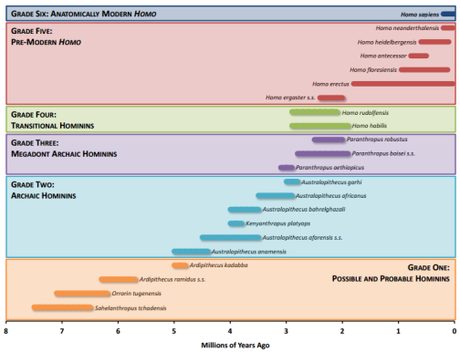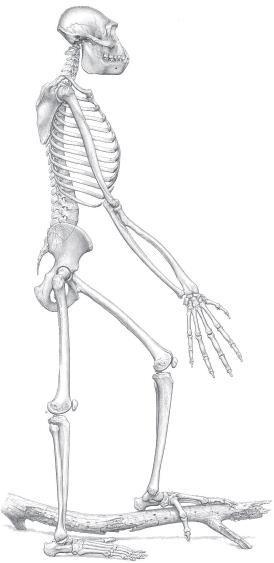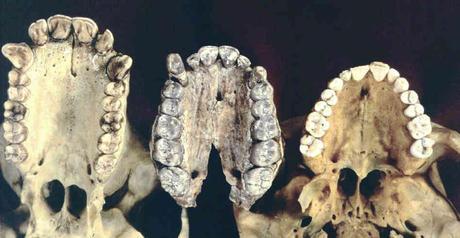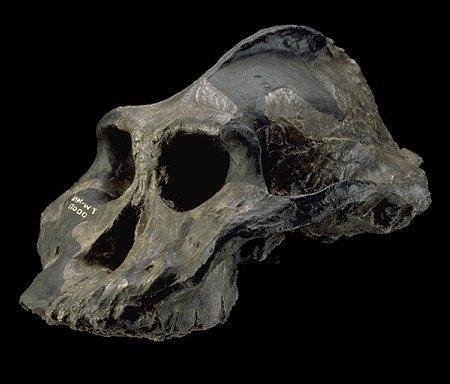A little while ago I was chatting to the author of the excellent eyeontheicr about the recent Dmanisi finds. He asked me how one identifies various hominin skulls. So, this is my quick and dirty guide on how to recognize your ancestors heads.
I’m splitting this up by grade rather than species. As the Dmanisi finds show, species can be very hard to spot. Grades are basically groups of similar species (and sometimes genera) that allow us to talk about the general trends and relationships in human evolution, without getting bogged down in taxonomy (which is only really fun for taxonomists).

Hominin grades (click for bigger image)
Grade 1: Basically chimps

The skeleton of Ardipithecus ramidus, a grade 1 hominin. The body is very chimp-like, with an opposable big toe and really long arms, despite the fact its upright.
Grade 1 hominins are those that lived right after our family split from chimps, around 7 million years ago. Key species include Sahelanthropus tchadensis, the earliest hominin known, and Ardipithecus ramidus; whose skeleton was about as complete as Lucy’s. They shed light on a critical moment of human evolution, but identifying them can be quite difficult.
This is because most uniquely human traits are relatively recent developments. Our big brains, flat faces, nakedness, unique teeth and use of tools all didn’t develop until well after grade 1 hominins lived. So how can we identify a species as human if the defining characteristics of humanity had yet to evolve? Well, it would seem that the first hominins still had one unique human trait: bipedalism. Or at least, upright locomotion. They may well have been “walking” along tree branches, rather than along the ground.
As such the key way to spot a grade 1 skill is the foramen magnum. This is the hole (foramen magnum is literally latin for “big hole”) through which the spinal cord connects to the brain; and so its location is dependent upon the orientation of the spine. In an upright creature with a vertical spine the hole is located towards the base of the skull, whereas in quadrupeds in chimps it is more towards the back.
So when trying to spot a grade 1 hominin, you’re basically looking for an ape that “walks” upright. There are a few other changes as well. The shape of their face and teeth might be slightly different from modern apes, but the real identifier is the foramen magnum.
Of course, the possibility remains that there might be another branch of upright apes out there (although none have been found). As such debate continues over whether or not the upright-ness alone is enough to justify classifying a fossil as hominin. Given how it is one of the key defining features of humanity share by no other primate I think it is. But never say never.
So, if you’re skull looks like a chimp but has a foramen magnum that suggests it was upright you have a grade 1 hominin. If you have a skull that looks like a chimp but doesn’t have said foramen magnum you probably have a chimp.
Grade 2: Man-chimps
Grade 2 hominins are beginning to look more distinctly human, although still mostly resemble chimps. They lived from 4 – 2 million years ago and includes Australopithecus and Kenyanthropus (which is similar to the former).
As with grade 1 hominins we’re still looking at species with small brains and chimp-like faces, but there is another key human development: the teeth. Chimps have very large canines and there is a fairly big size difference between the sexes. In humans, as you may have noticed, our canines are almost no bigger than our other teeth and there is no noticeable difference between the genders. This is also the case with grade 2 hominins.
There are still some major differences between our teeth and grade 2 teeth. Primarily they were bloody massive. The molars of grade 2 and 3 hominins are the biggest of our whole family, even bigger than those of chimps. Many think that this is linked to a shift in diet that came from spending more time on the ground.

A chimps teeth (left), grade 2 teeth (middle) and human teeth (right). The canines of grade 2 hominins are much smaller than a chimps, but check out how huge their molars are
Because if you are fortunate enough to have a bit of the body along with your skull then you’ll note that it is well adapted for walking upright on the ground. Their feet no longer have an opposable big toe, their spine is curving to make sure they stay balanced in an upright position, their walking muscles are getting more powerful and their pelvis is changing shape to better accommodate them.
So a grade 2 hominin is basically a chimps head with big, yet human-looking teeth and a body that’s well suited for walking on the ground.
Grade 3: Human cows

A megadont hominin. Key features include the prominent crest, wide cheeckbones and dished face
Grade 3 hominins are called “megadonts”. This is fancy science talk for “really big teeth”. And that’s their defining characteristic: huge teeth and a massive jaw to hold them. Aside from that they’re not really any different from grade 2 hominins. They still have small brains, projecting chimp faces and bodies that are becoming increasingly well suited to life on the ground.
So, to spot a grade 3 skull you’re looking for a huge jaw, massive cheekbones and a very prominent crest on the top of the skull. These are all adaptations for hugely powerful chewing muscles that would anchor on the crest, travel through the cheekbones and give the big jaw tremendous power. As a side-effect of these changes grade 3 species also often have “dished” face.
These features earned the first grade 3 hominin found the nickname “nutcracker man”. Surprisingly, microwear analyses of damage to the teeth suggests they weren’t cracking nuts, or really chowing down hard on anything. So why the massive jaws? Perhaps it was an adaptation to tougher food that needed grinding down, or maybe just to give them the stamina to process large quantities of low quality food. Like grass, hence my preferred nickname: human cows.

